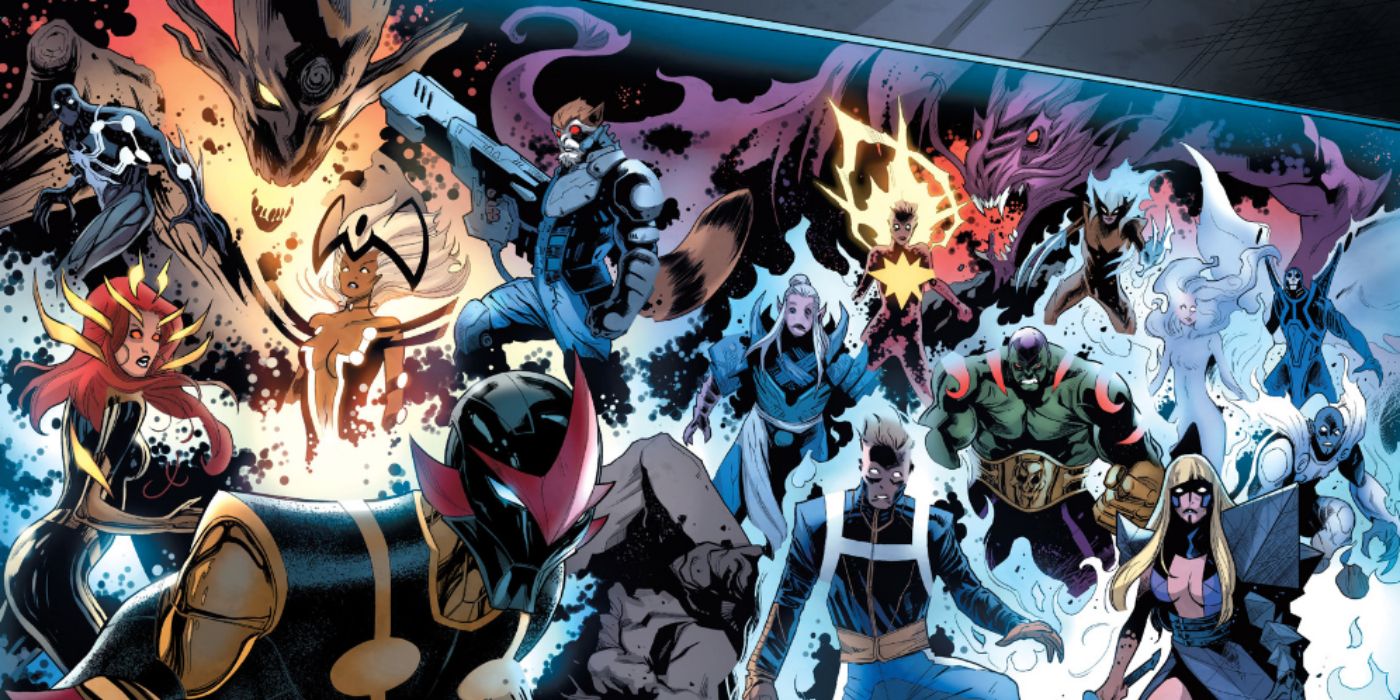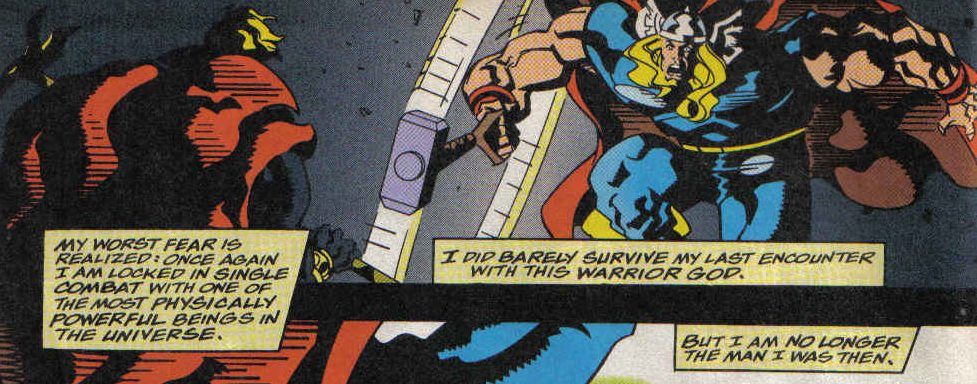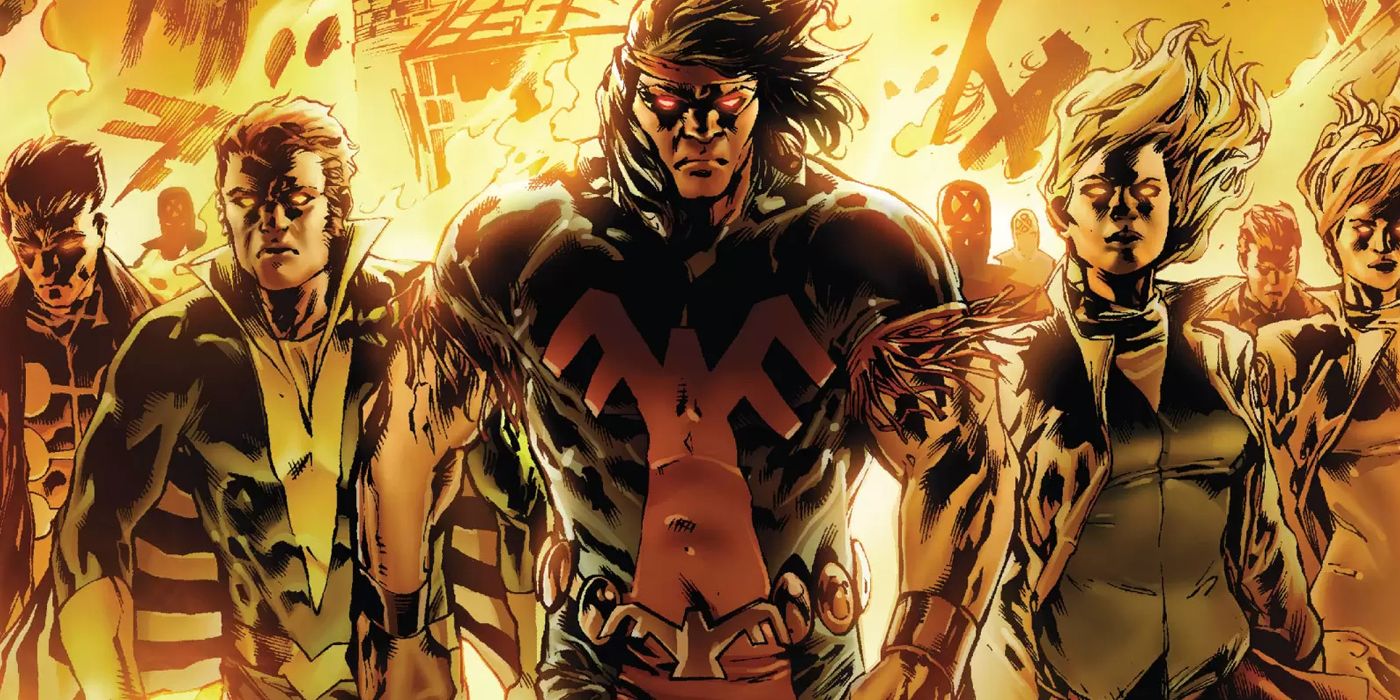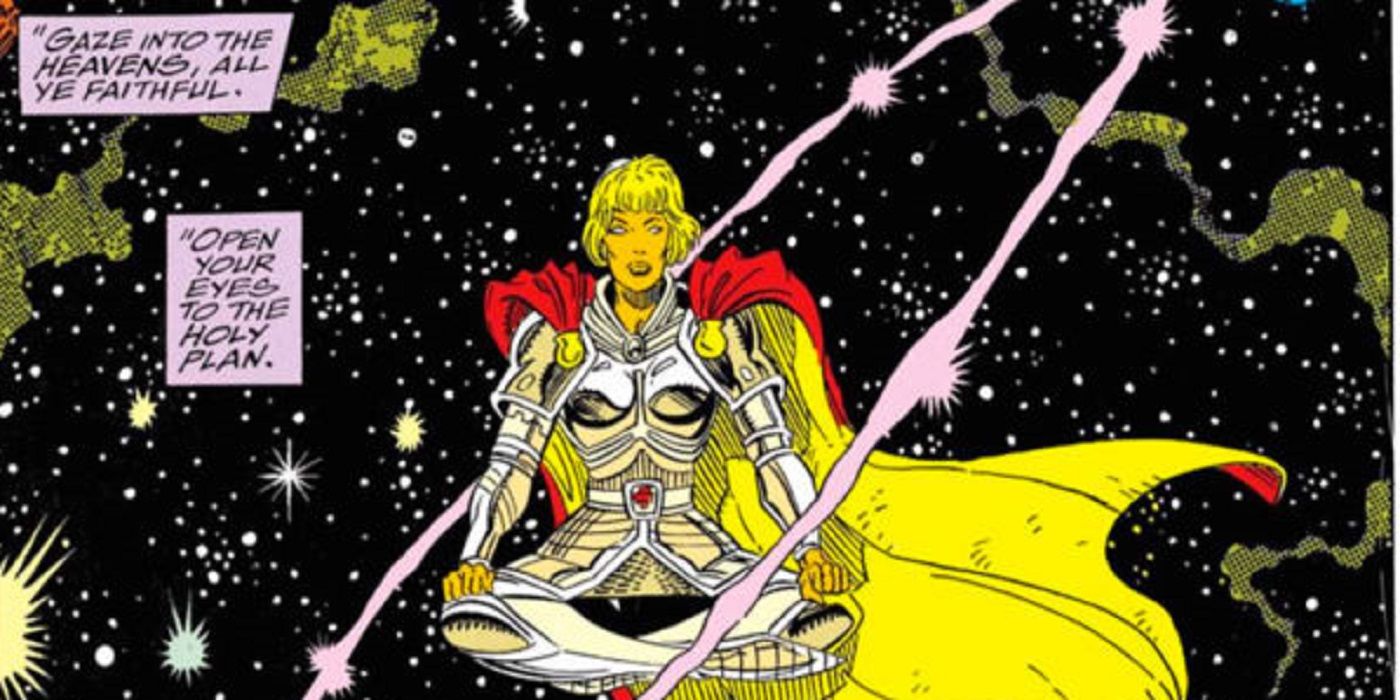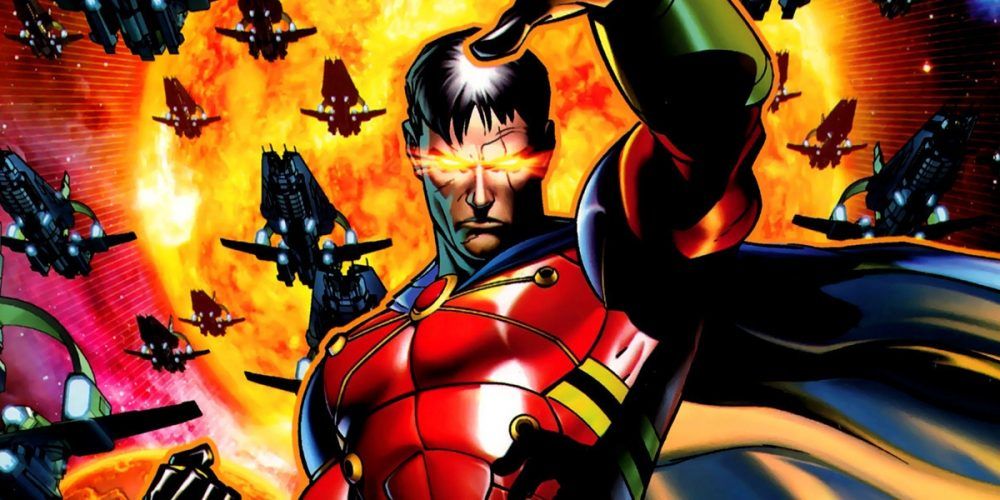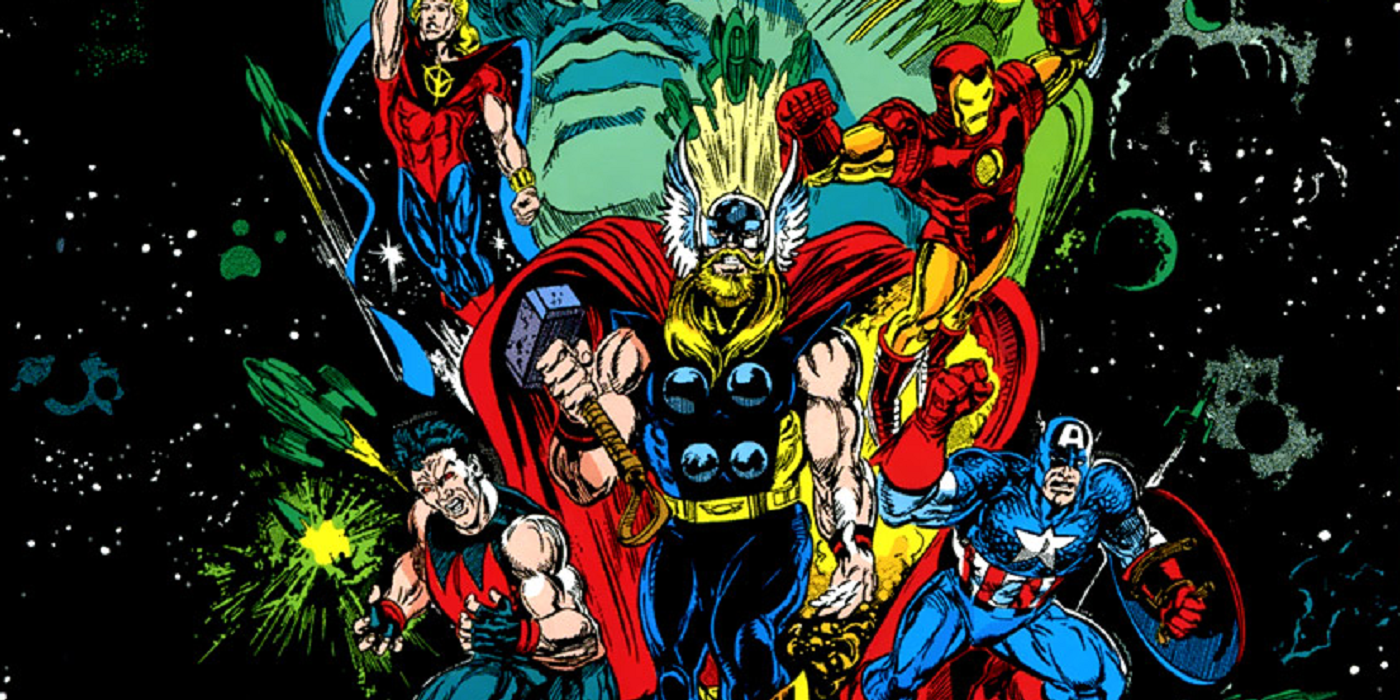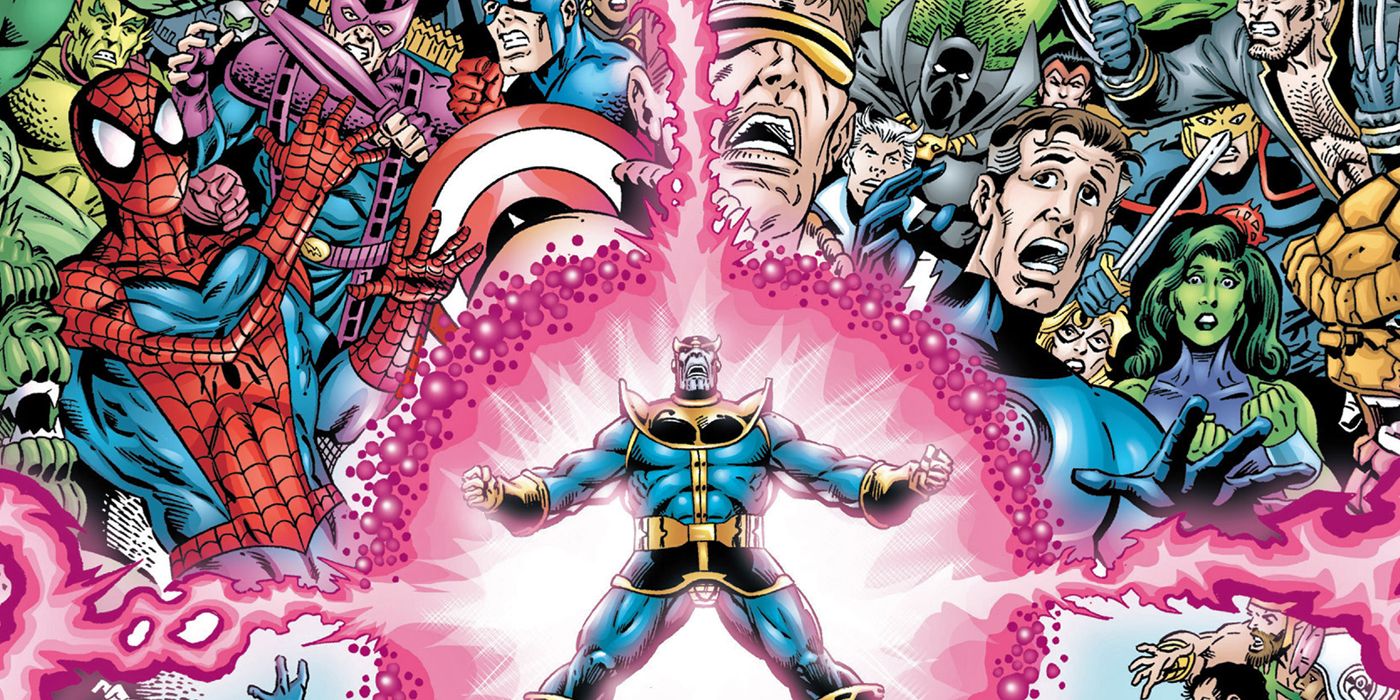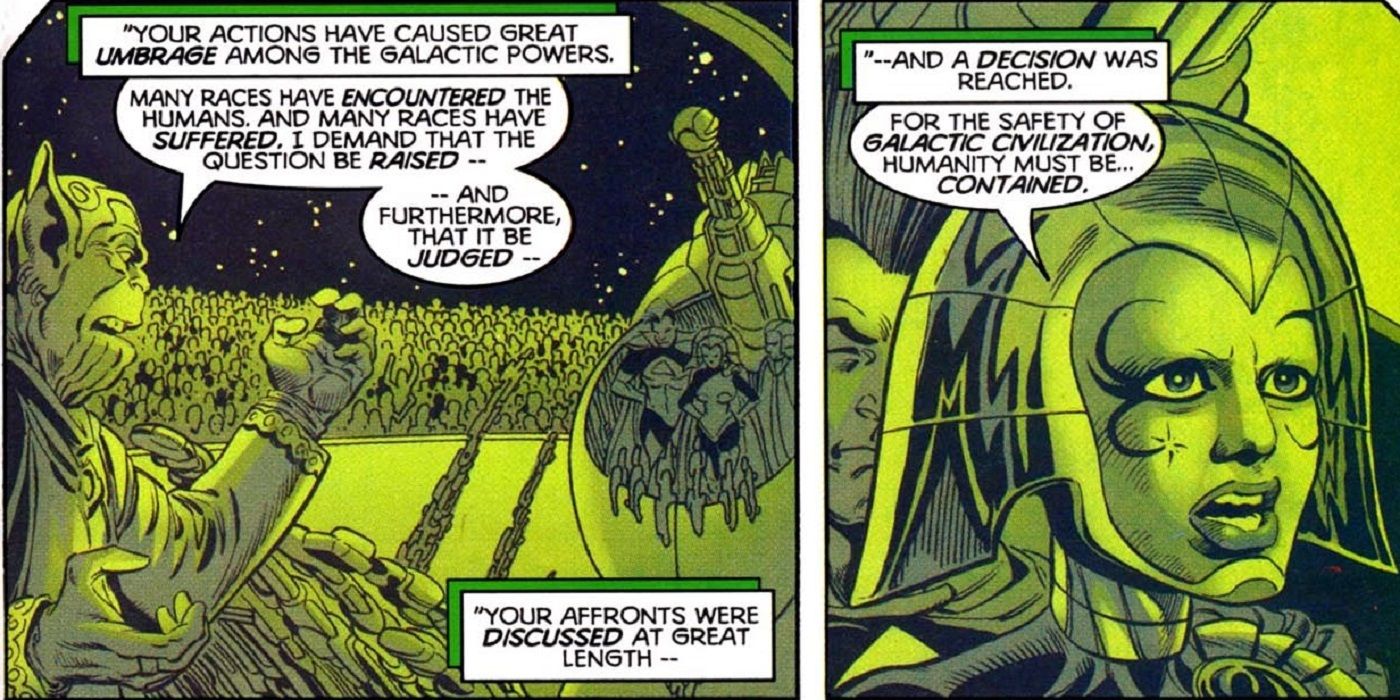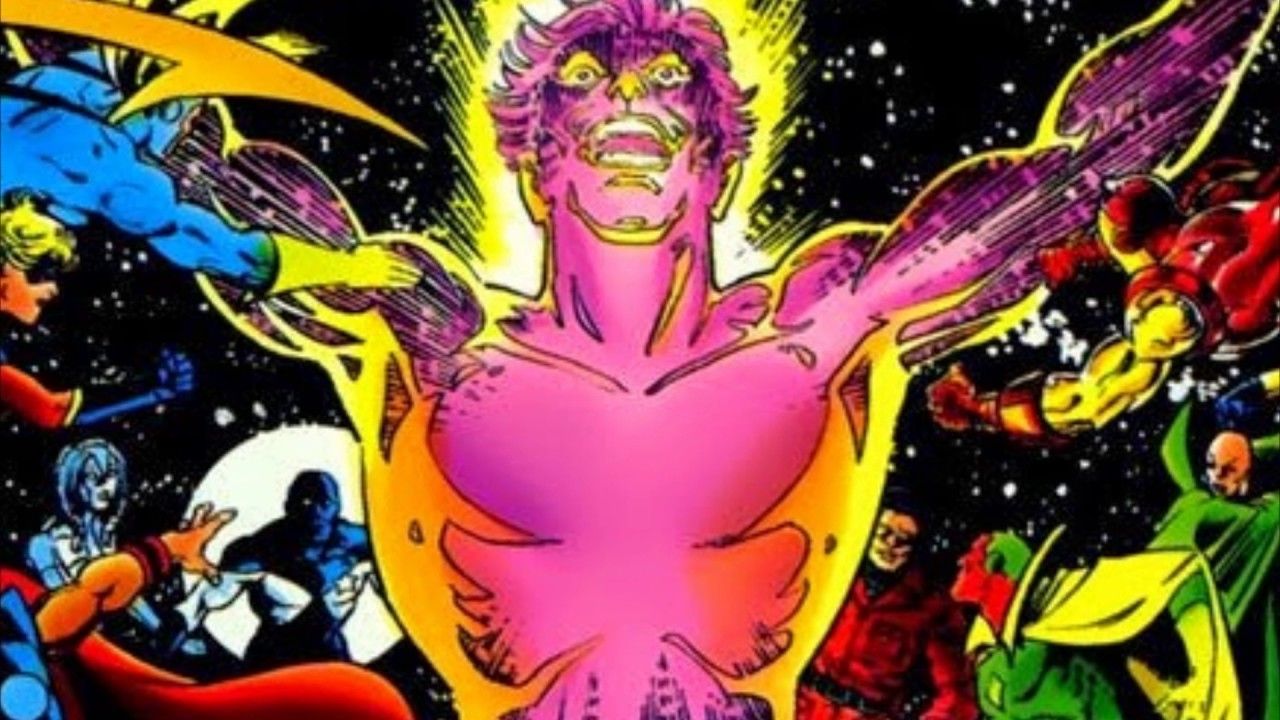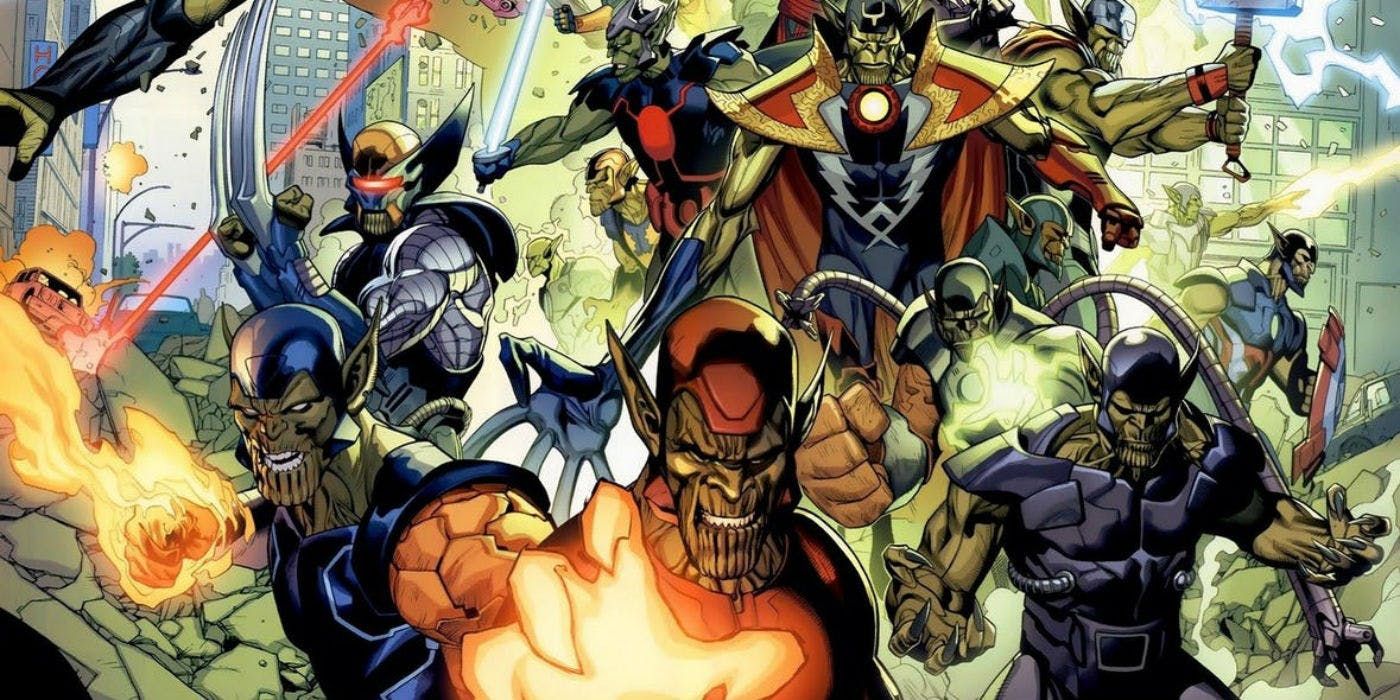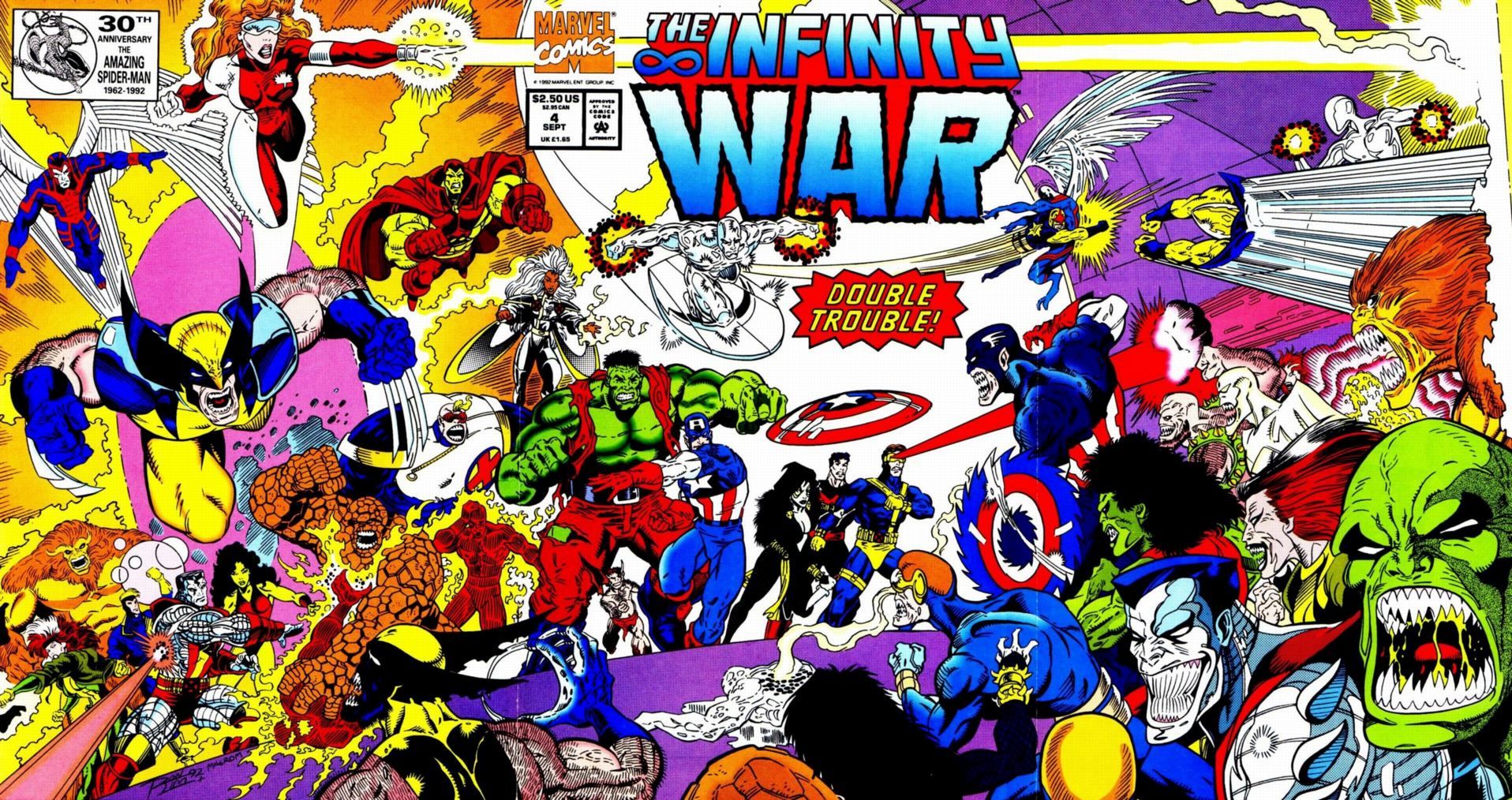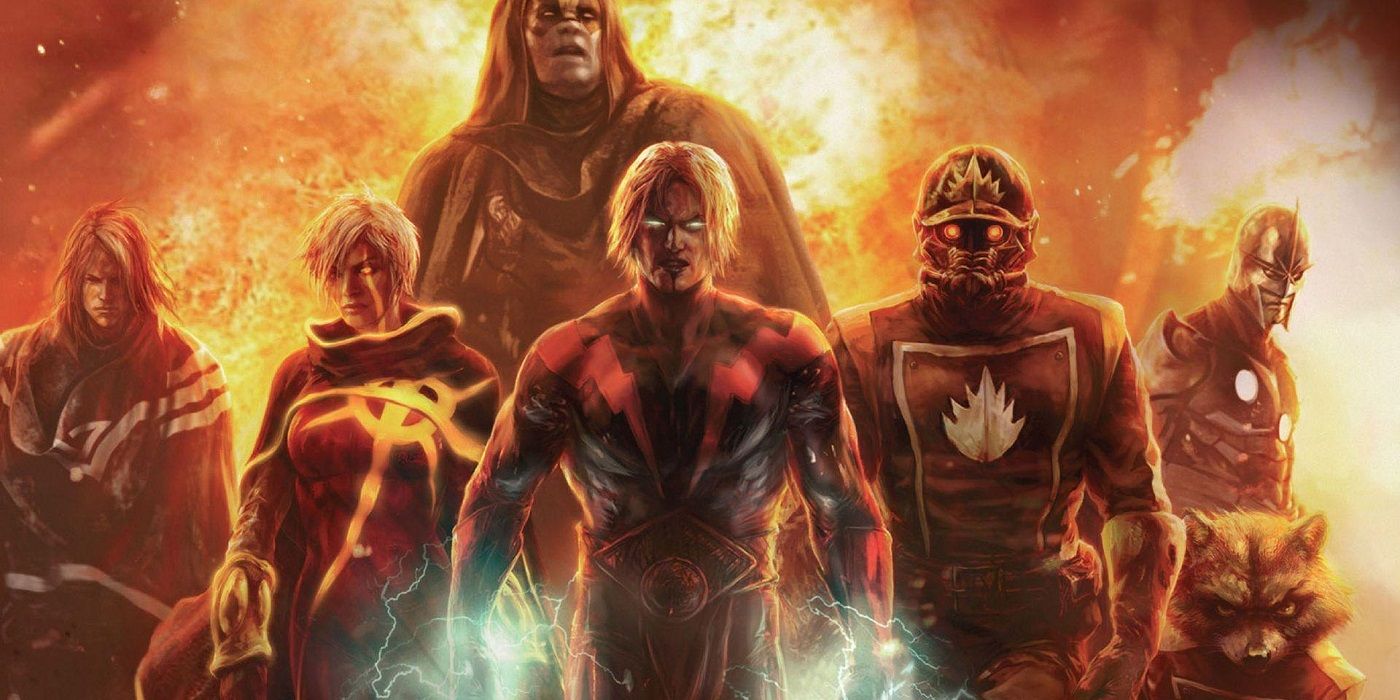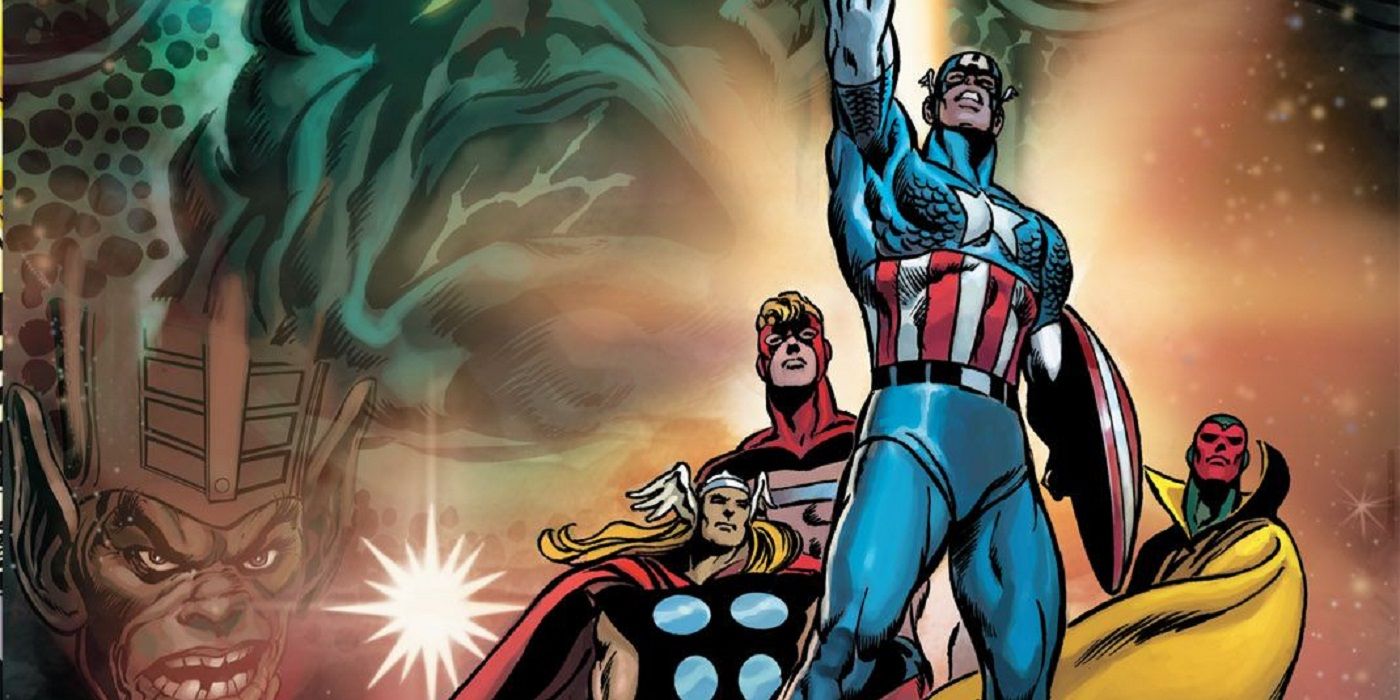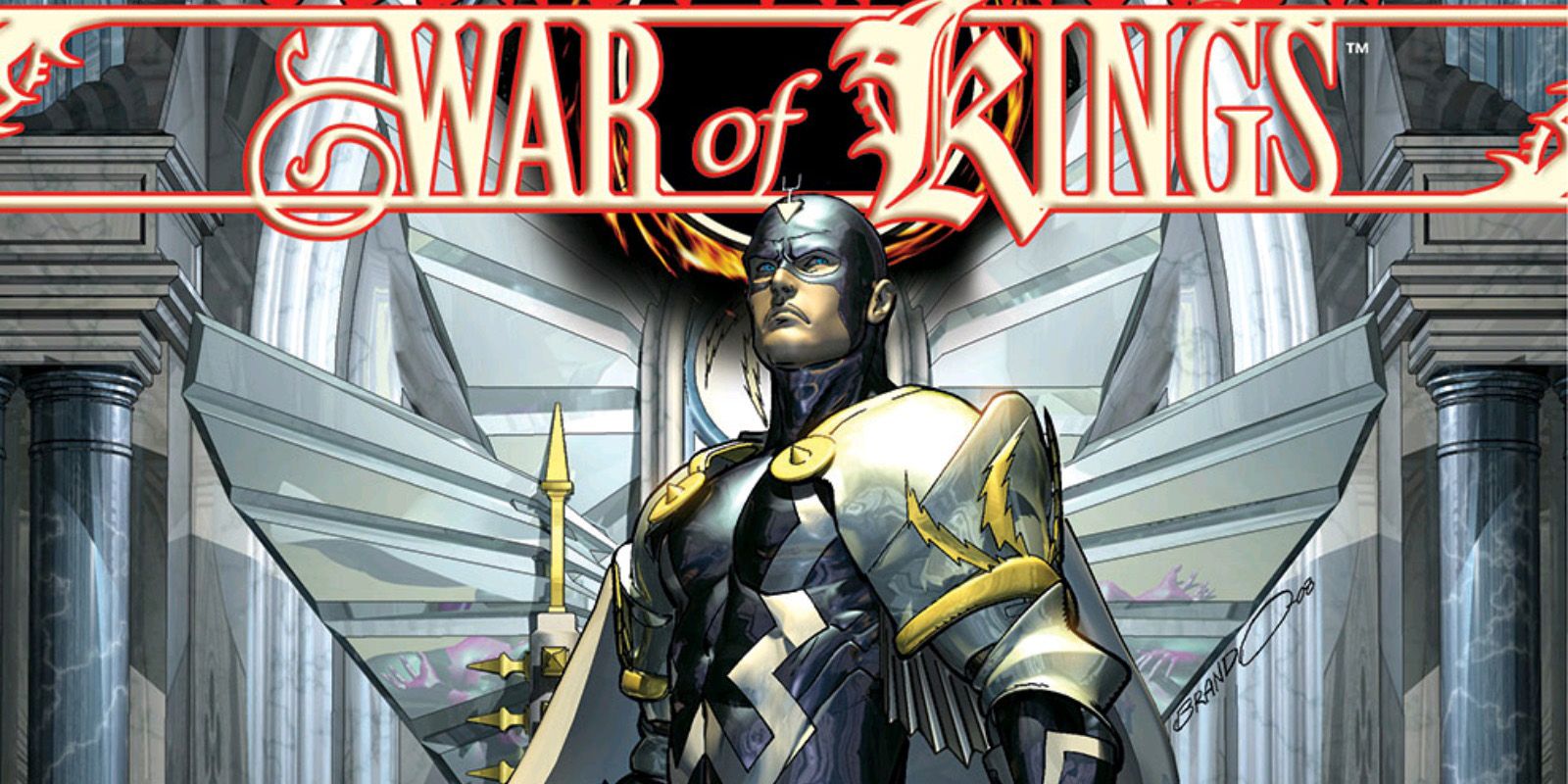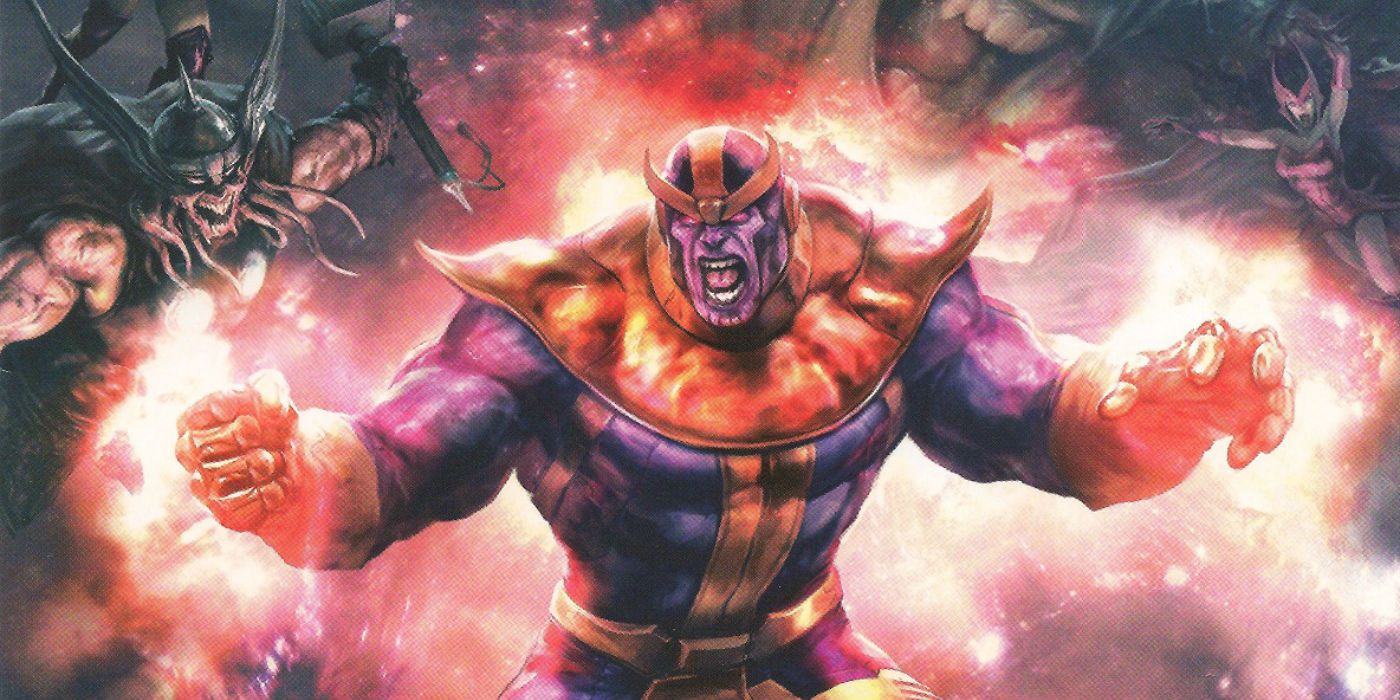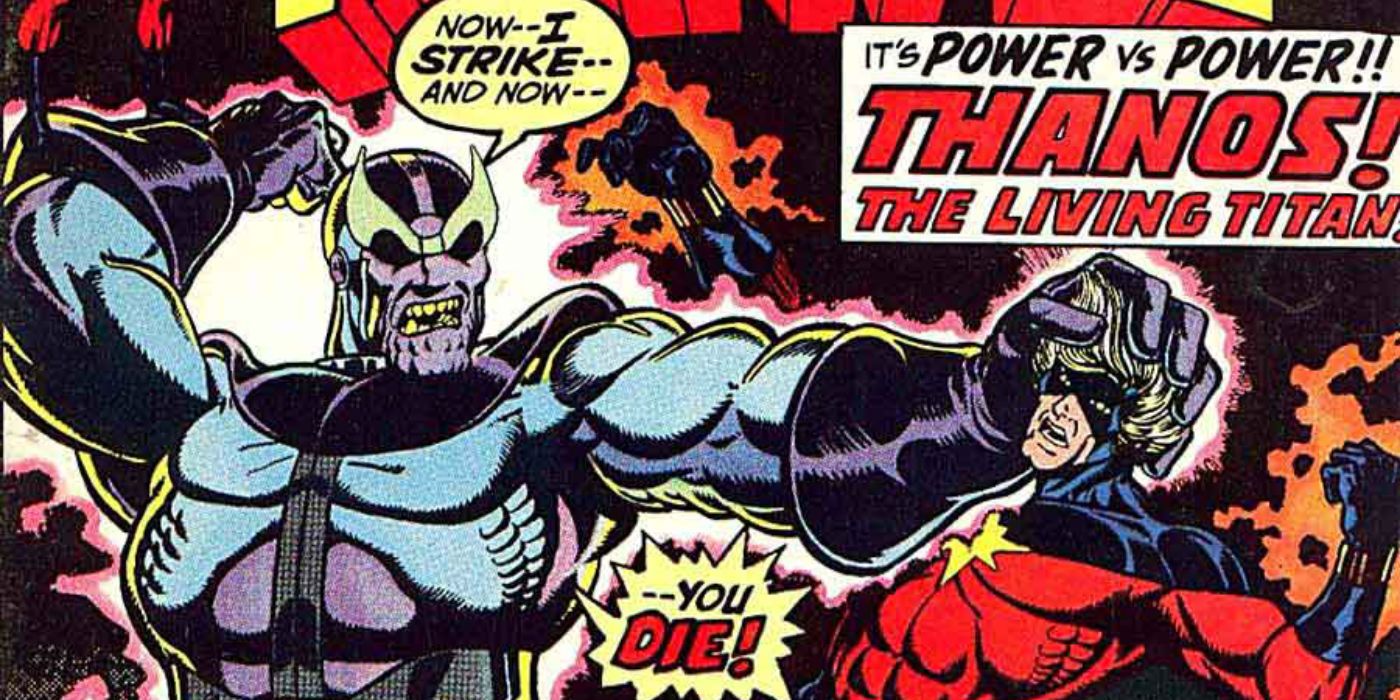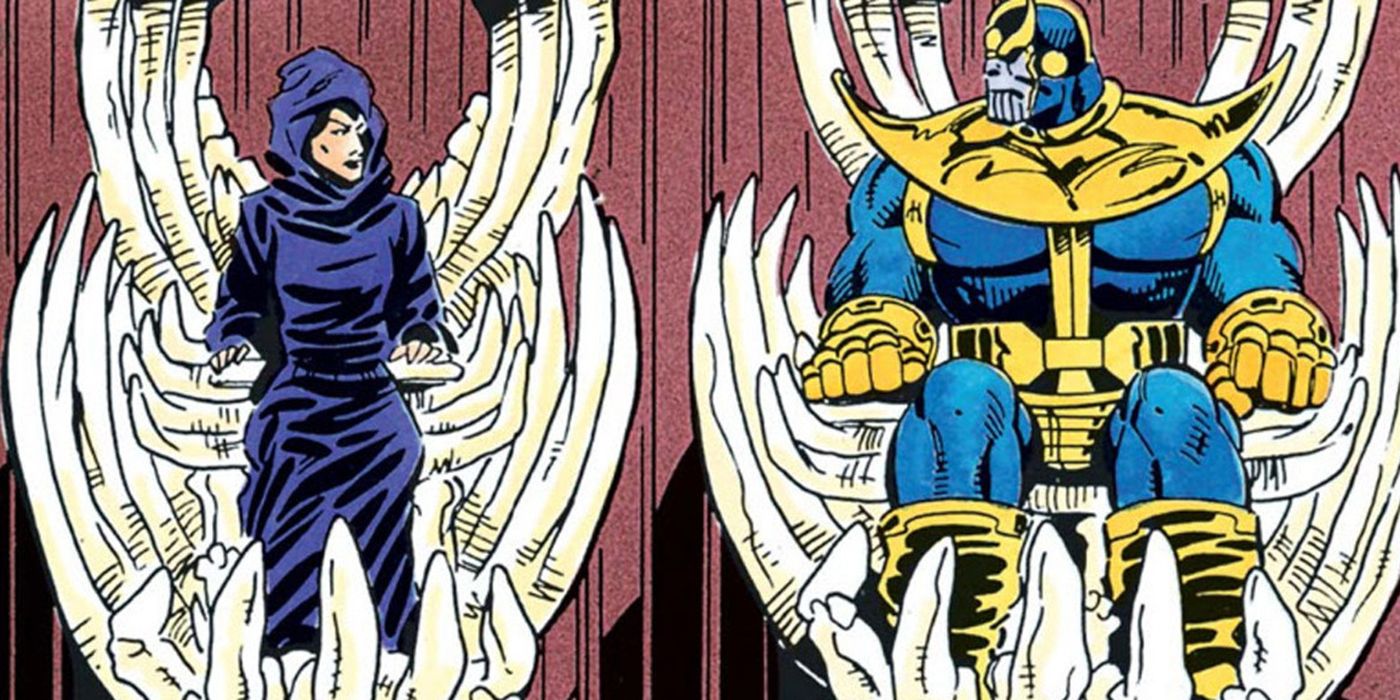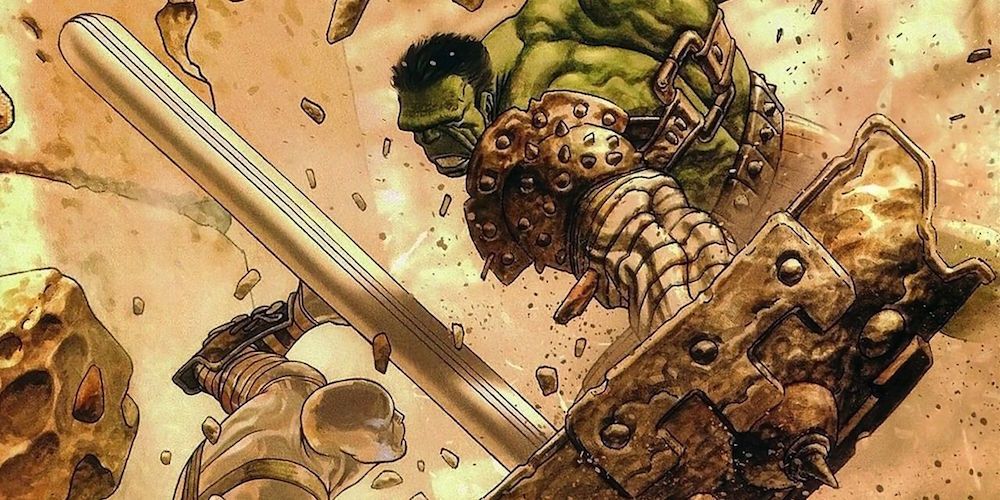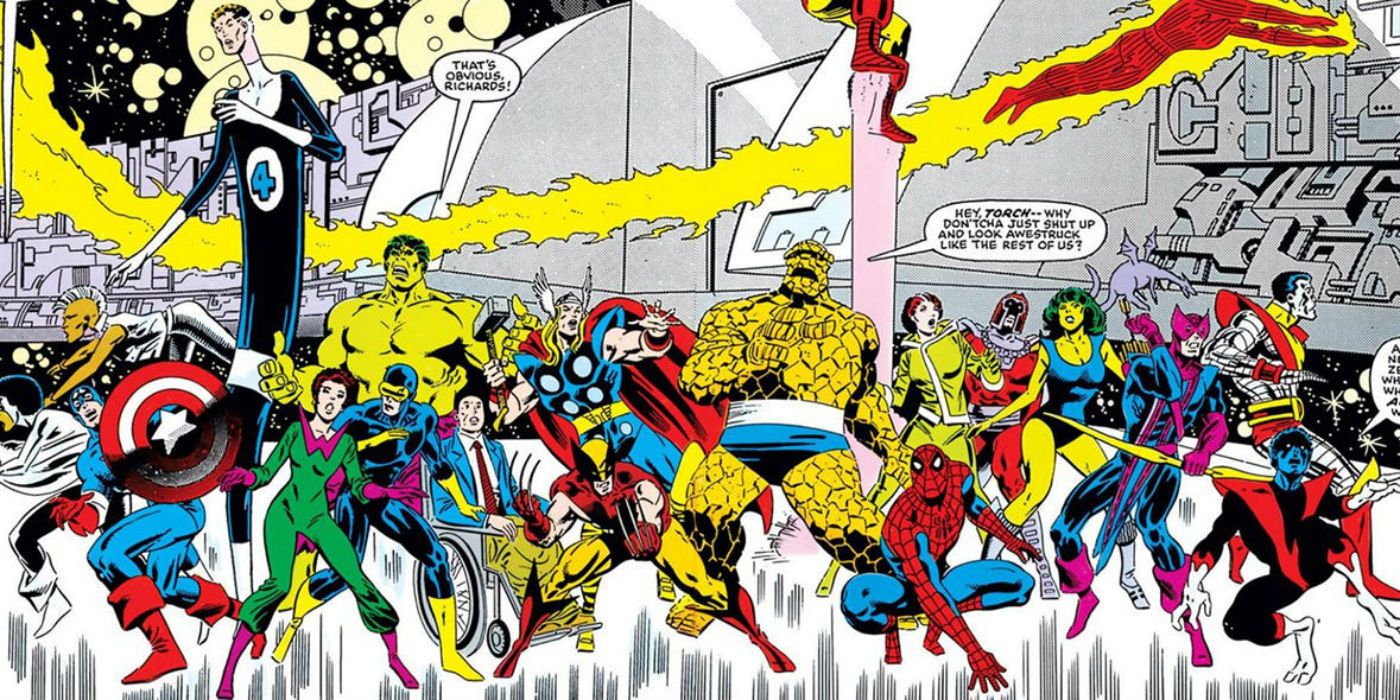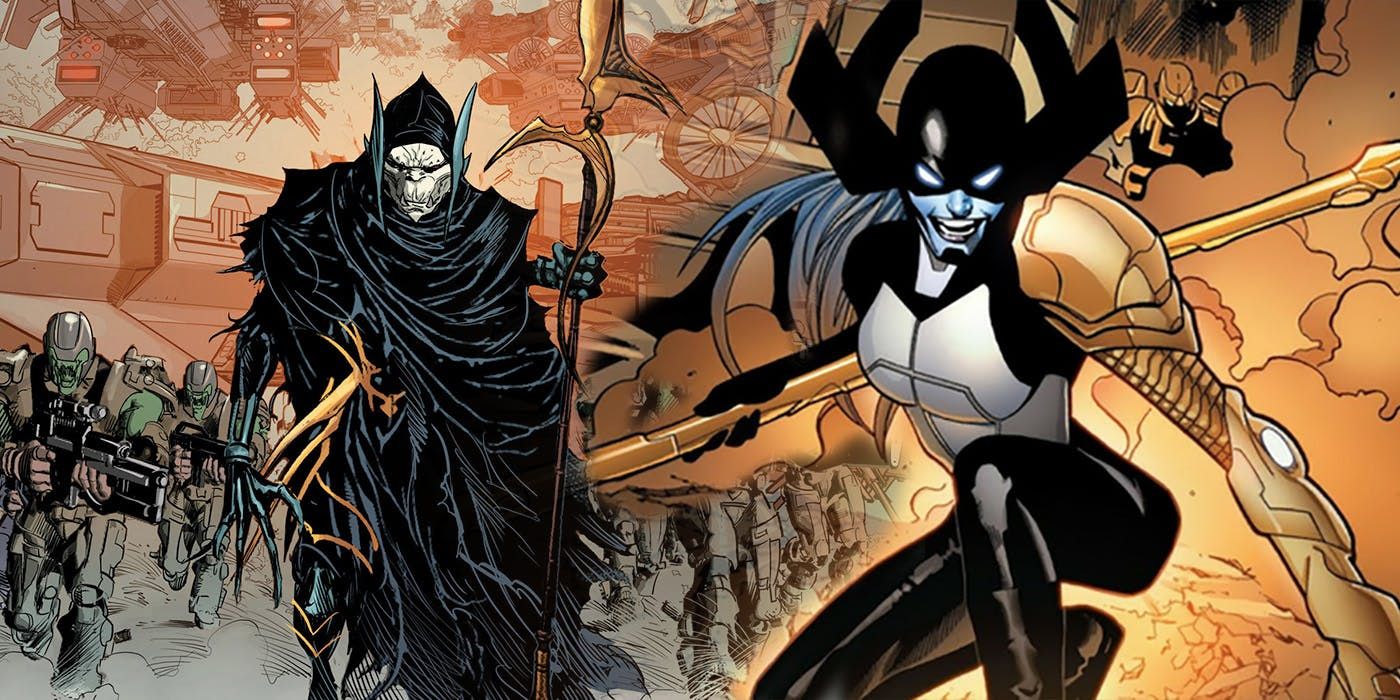Marvel's cosmic landscape has given readers some of the absolute best of the shared universe, and has shaped and inspired much of what movie goers love about the Marvel Cinematic Universe to date. In many ways, Marvel Comics has been rooted in the stars from go, with Fantastic Four #1 launching Marvel's first family into space (where they were famously bombarded by cosmic rays), only to encounter the alien Skrulls in their next adventure.
As the cosmic landscape has grown from alien characters like Silver Surfer, Captain Marvel, and Galactus to cosmic entities like Eternity, Lord Chaos, and Master Order, events set light-years from New York have filled Marvel's roster of stories. In modern comics throughout the '00s, space-faring heroes like Nova and the Guardians of the Galaxy have held their own as fan-favorites, and the same can be said of cosmic villains like Thanos. Marvel's 2018 core events are playing into the realm of the cosmic as well, with "Infinity Countdown" and the impending "Infinity Wars" set to shape the state of the shared universe. Ranking the entirety of incredible cosmic events like "Annihilation" and "Infinity Gauntlet" is no easy task, but nonetheless, below you'll find a complete guide to Marvel's cosmic events, from worst to best.
26 X-MEN & GUARDIANS OF THE GALAXY: THE BLACK VORTEX
Following his work on the crossover between Guardians of the Galaxy and All-New X-Men in "The Trial of Jean Grey," writer Brian Michael Bendis brought the teams together once more for a proper event in "The Black Vortex." Frankly, the mega Marvel NOW! crossover might have benefited from Bendis' sole writing duties, rather than sprawling across a vast array of tie-ins. At its core, "The Black Vortex" simply doesn't offer enough story to justify its endless collection of pages, and offers very little to the overall legacy of Marvel cosmic comics.
Its overly reductive, but "The Black Vortex" is essentially a Dark Phoenix machine crafted by Celestial powers.
To its credit, the event draws in cosmic elements like Thane, son of Thanos, the Collector, and even the Black Order's Ebony Maw. Similarly, Groot does find himself with enhanced cosmic powers, which is always a win. Unfortunately, this is far from enough to save a forgettable event that pales in comparison to the state of Marvel cosmic events only five years prior. To wit, the big moment of revelation of the event occurs when Kitty Pryde uses the Vortex to enhance her powers to the point she can phase an entire planet -- at best an homage to the conclusion to Joss Whedon and John Cassaday's work on Astonishing X-Men and at worst derivative refried plot.
25 THOR: BLOOD AND THUNDER
Thor's "warrior madness" was quite the ongoing driving plot during the Ron Marz written mid-'90s run on the character, ultimately leading to one of the more disappointing events of the decade in "Blood and Thunder." Apart from sounding like a decent name for a Slayer cover band, "Blood and Thunder" is little more than a stretched out excuse for Thor to hit lots and lots of characters and things. As exposition throughout the event is all too eager to remind you, Thor's totally lost his wits, and it's up to the likes of Adam Warlock, the Infinity Watch, and -- believe it or not -- Thanos to keep him from destroying Asgard.
Although Thor's always poised to hold his own among the biggest and best of Marvel cosmic, "Blood and Thunder" fails to live up to those expectations. While it's hardly unique to superhero comics, the sheer volume of fights that even the simplest communication could have prevented is overbearing. Likewise, while it's fun to see Thor match strength against Beta Ray Bill, Thanos, and even Odin, it's less fun to see the hero callously backhand on and off again love interest, Lady Sif. There's a kernel of interesting story throughout, but "Blood and Thunder" is an overall let down.
24 CHAOS WAR
Spinning out of the pages of Greg Pak and Fred Van Lente's excellent work co-writing Incredible Hercules, the "Chaos War" event landed with minimal fanfare or legacy. Although the core memorable moments are an extension of Hercules' story, and the return of various dead Avengers, "Chaos War" also boasts substantial cosmic elements. As a matter of fact, it could be argued that the Chaos King's rise and desire to completely unravel life in the universe operates on a scale similar to cosmic events like "Infinity Gauntlet."
Since the stakes are so egregiously high, and the power sets so unwieldy, it is left up to Hercules and Thor to assemble the "God Squad" in an effort to prevent the Chaos King's mad schemes.
At the end of the day, "Chaos War" is a firmly middle of the road event that fails to capture enough of the promise from Pak and Van Lente's combined storytelling with the characters of Amadeus Cho and Hercules up to that point. As with any modern event that plays with resurrection and returning characters, there is meaningful fallout. Nonetheless, the absolute best that can be said for the event is that it operates in a relatively tight set of tie-ins and crossovers, and effectively concludes an era of excellent Hercules comic books.
23 INFINITY CRUSADE
It will always remain the unsatisfying, largely overlooked conclusion to the early '90s Infinity saga, but Infinity Crusade has some compelling ideas. Much like he did the the universal church of truth in the mid '70s, writer Jim Starlin continues to skewer religious dogma in a direct way few superhero comics before or since have even approached. And much like we saw in the preceding Infinity War, it's largely up to Thanos and Adam Warlock, working together again, to prevent disaster on a cosmic scale.
Unfortunately, after the cosmic landscape altering action of Infinity Gauntlet, and the zany team-ups between the likes of Kang the Conqueror and Doctor Doom in Infinity War, the "Crusade" is a let down. Starlin is doing familiar work on themes around absolute certainty, religion, and power structures, but Adam Warlock's "good half," aka The Goddess, just isn't all that compelling of an evil entity. Likewise, so many of the Marvel heroes are mindwiped into doing the bidding of The Goddess, that the event becomes a frustrating meditation on what the Marvel Universe would look like if half the heroes suddenly "got religion." As a standalone, Infinity Crusade is passable, but it does work better when read as a part of the complete original Infinity saga.
22 X-MEN: RISE AND FALL OF THE SHI'AR EMPIRE
Spiraling out of the revelations in X-Men: Deadly Genesis, Vulcan (aka Gabriel Summers, the third Summers brother) took to space to seek revenge on Emperor D'ken and the Shi'ar Empire. Long story short, Vulcan is successful, and murderizes Emperor D'ken in front of the whole Shi'ar guard. Frankly, it was a long time coming and couldn't have happened to a crueler tyrant. Lest we forget, there's a long standing X-Men theory that D'ken is responsible for fathering a fourth Summers brother, aka Adam-X the Xtreme. With this assassination well and out of the way the throne is warmed up for the all new Emperor Vulcan, ruler of the Shi'ar!
At the end of the day, though, the best thing about "The Rise and Fall of the Shi'ar Empire" is the name and concept.
Despite Ed Brubaker's involvement as writer, the event is a middling cosmic affair, featuring prominent roles for Havok, Polaris, and Professor X. "Rise and Fall" does do the legwork provided to set the stage for Vulcan and Gladiator in "War of Kings," but the story doesn't leave too many memorable moments behind otherwise. The best of the event is what happens to the Uncanny X-Men and Marvel cosmic lines after this point in time.
21 OPERATION: GALACTIC STORM
"Operation: Galactic Storm" suffers primarily from two major hurdles. First, the plot is a severe rehash of the more well-known "Kree/Skrull War," with the Skrulls merely replaced by the Shi'ar. Perhaps more importantly, "Operation: Galactic Storm" also seems to run forever, with well over 20 tie-ins when things are all said and done. That said, it can't be said that this Avengers cosmic event doesn't know how to deliver on an unfathomable scale. Much of the event centers on the creation and use of a Shi'ar "nega-bomb," which does in fact detonate and terminate billions of Kree lifeforms. In actuality, it took nearly a decade of publishing time for the Kree to return to their previous status as one of the galaxy's top civilizations.
Intriguingly, the event centers very much on Quasar, who has very much become an underutilized cosmic player in present day Marvel Comics. To its credit, "Galactic Storm" also taps into the personality differences of Captain America and Iron Man, culminating in their difference of opinion on a vote to kill the Kree Supreme Intelligence. Iron Man and various Avengers are in agreement with shellhead defy Captain America's orders to let the Supreme Intelligence live (or so it seems).
20 MARVEL UNIVERSE: THE END
Although he'd been at it for decades, it actually took until the early '00s for Thanos to well and truly wipe out the entire Marvel Universe. "The End" also makes a strong run at the award for strangest Marvel cosmic event (especially among those involving Thanos). Written and drawn by Jim Starlin, with inks by Al Milgrom, Marvel Universe: The End is six issues spanning nearly all of known time and space. The cleanest definition of the event focuses on the cosmic energy of "The Heart of the Universe," and its use to wipe out Marvel heroes by the time traveling pharaoh Akhenanten.
The most memorable moments of the event center on Thanos once again achieving unbridled power, only to successfully destroy and recreate the entire universe.
Amazingly, the entire series is so unwieldy that Marvel editorial has stated it simply remains out of established continuity. In general, "Marvel Universe: The End" is most noteworthy for effectively setting the stage toward the 12-issue solo Thanos series that writer Jim Starlin would deliver the following year. As such, the event becomes a must-read for Thanos die-hards (die-harders?) only, without much else to grasp on to unless you're already all in on ol' purple puss.
19 MAXIMUM SECURITY
"Maximum Security" is a fun concept that falls victim to bad timing. As Ronan the Accuser boisterously declares on the cover of Maximum Security #1, "From this day forward Earth shall be a prison!" The early '00s event doesn't quite fit in with the Marvel Knights era of rejuvenated creative energy, and occurs just a few years too early to connect in any meaningful way to "Avengers: Disassembled" and "Annihilation" sparking the modern era of Earth bound and cosmic Marvel events. Likewise, the core "Avengers Infinity" squad is a tougher sell for modern readers, with a lineup of Thor (great), Quasar (uh-huh), Starfox (sure), Moondragon (yeah...), Photon (still using that name, huh?), Tigra (in space?), and Jack of Hearts (nope).
Conceptually, though, "Maximum Security" is very much in line with lines of thinking that writers like Brian Michael Bendis have expanded in more recent years, with various alien civilizations seeking to prevent Earth heroes from further interference on a galactic scale. Plus, there are awesome cosmic concepts at play throughout the event, like Ego the Living Planet being imprisoned on Earth, where he begins to grow and attach himself to the planet! Not to mention the fact that Quasar's plan for containing the growing Ego involves storing him in his Quantum Bands!
18 THE KORVAC SAGA
Your affinity for late '70s Marvel cosmic, the Avengers, and the original Guardians of the Galaxy will go a long way to determining your worth of the classic "Korvac Saga." Indeed, Michael Korvac comes from the original Guardians 31st century, and essentially becomes a cyborg hellbent on uncovering and understanding the Power Cosmic. Like many "noble" villains, Korvac's aims are to force the Earth into his version of a paradise, and arguably his desires may have been genuine.
The most memorable development from the saga comes when the combined might of the Avengers and Guardians of the Galaxy proves nowhere near potent enough to combat the near omnipotence of Michael Korvac.
The god-like threat doesn't just beat the Avengers, he mows them down with ease, and literally leaves the floor of his Queens, New York home scattered with the bodies of shattered heroes. The Avengers and Guardians are only able to "defeat" Korvac when he commits a generally difficult to understand version of self-righteous suicide. In a truly cosmic turn, Korvac's suicide is at least in part centered on his relationship challenges with girlfriend Carina, who is herself the daughter of The Collector. Truth be told, it isn't truly a cosmic comic until an elder of the universe is concocting an incomprehensible plan.
17 SECRET INVASION
The Skrulls have been unsuccessfully trying to invade planet Earth since Fantastic Four #2 (when Johnny Storm showed them a copy of a Marvel monster comic and they freaked out), and in 2007 they came as close to absolute victory as they ever may. Long known as warring shape-shifters, the Skrulls developed the ability to scientifically mirror the heroes of Earth that have vexed them throughout time. By implanting sleeper Skrulls in all areas of Earth (S.H.I.E.L.D., the Avengers, mansion cleaning staff) the Skrulls are able to completely take the Earth by surprise.
In a lot of ways, the build up to "Secret Invasion", and the mystery behind the villainous forces laying in wait for the New Avengers is much more tantalizing than the actual event. We still get excited thinking about the shadowy benefactor funding Electro's breakout of the super-villain prison, The Raft. Nonetheless, the tag line "Who can you trust?" plays out effectively, with heroes completely in the dark about how might actually turn out to be a Skrull. Of all the Brian Michael Bendis written Marvel events of the '00s, "Secret Invasion" is truly the most cosmic, relying on the reader's knowledge of the status of the Skrull population after events like Galactus and "Annihilation" struck their population.
16 INFINITY WAR
Now forever known as the title of Avengers 3, "Infinity War" the comic book event will go down as a forever underrated sequel to 1991's Infinity Gauntlet. Admittedly, fans of the MCU version of the story turning to Infinity War #1 for similarities are in for a wild ride. For all intents and purposes, "Infinity War" the comic book event picks up where Avengers: Infinity War ends.
Thanos is living his best retirement out on the farm, when the Magus -- Adam Warlock's evil half -- returns with the full might of five cosmic cubes and an army of Earth hero dopplegangers!
"Infinity War'" delivers deliciously enjoyable team-ups like Thanos working with Warlock and the Infinity Watch (including "daughter" Gamora and nemesis Drax the Destroyer), and Doctor Doom and Kang the Conqueror scouring the edges of the war in their own pursuit of power (silently vowing to murder the other the entire time!). Not to mention the fact that Galactus recruits Doctor Strange in his own efforts to prevent the Magus from universal domination and destruction. As a whole, the event is uneven and descends into writer Jim Starlin's penchant for swollen philosophizing, but there aren't too many books that rival the scope on display.
15 ANNIHILATION CONQUEST
While not as good as the original, the sequel to "Annihilation" is an essential driving engine behind one of the greatest moments in Marvel cosmic history, and the launching pad for the modern Guardians of the Galaxy. Sure, the Annihilation: Star-Lord miniseries is a Guardians try out in which Groot still speaks in full sentences like a terrifyingly menacing Monarch, but not everything finds its groove right out of the gate. For all intents and purposes, "Conquest" does a respectable job following through on the all-or-nothing stakes of "Annihilation" without simply reheating the initial threat posed by Annihilus and his unending hordes. That said, because of what grew from the event's legacy (aka the Dan Abnett and Andy Lanning written Guardians of the Galaxy ongoing) it's hard to view the event as much more than a stepping stone to bigger and better modern cosmic stories.
More than anything, "Annihilation: Conquest" is memorable for pulling in unexpected Marvel Universe regulars and adding them to the cosmic tapestry. The Phalanx (previously peaking with X-Men: The Animated Series and a legacy of "the weird X-Men crossover that launched Generation X") are the most obvious cosmic threats here, until revelations of the High Evolutionary and Ultron come into play.
14 THE KREE/SKRULL WAR
The early 1970's "Kree/Skrull War" is one of the most iconic Avengers stories, with a legacy that extends all the way to mid '00s stories like New Avengers: Illuminati. Writer Roy Thomas joins (primarily) artist Neal Adams to craft one of the farthest reaching Avengers stories to that point in Marvel history. The event spans the history of the Inhumans and the Kree empire, with the Supreme Intelligence operating as a primary driver of the narrative. The event ran for nearly a year of Avengers comics, spanning issues #89 to #97.
As a whole, the "Kree/Skrull War" is an impressive feat, calling back to the history of Marvel Comics while simultaneously developing visions of the future.
Perhaps best of all, writer Roy Thomas finds inspiration in the pages of Fantastic Four #2, and has three cows attack the Vision, only to reveal they are the Skrulls imprisoned on Earth by Reed Richards nearly a decade ago in Marvel Comics publication time. The event spans a wide variety of characters and locations from there, and introduces the bonkers concpet of Rick Jones' "Destiny Force." It's an all-time classic for good reason, whether talking cosmic comics or just Marvel in general.
13 WAR OF KINGS/REALM OF KINGS
For any number of reasons, the Marvel cosmic collection of civilizations are far more inclined to support monarchies than us lowly Terrans. "War of Kings" taps into this wealth of royalty with the likes of Black Bolt and the Inhumans, Vulcan, Gladiator and the Shi'ar, and Blastaar, King of the Negative Zone! Likewise, "War of Kings" finds the cosmic foundations formed in the wake of "Annihilation" suddenly at odds with one another rather than an existential, rapidly accelerating outside threat. The Kree and Shi'ar empires are the primary civilizations at war, meaning it's a challenge for the rest of the galaxy to avoid the fallout of their bloodshed.
"War of Kings" is also better for more noticeable connections to typically Earth centric heroes like the X-Men and Inhumans. Readers also get tie-in issues from Nova and Guardians of the Galaxy, two comic books firing on all cylinders as they head into the battles of raging monarchies. Alongside the more loosely focused follow-up event "Realm of Kings," the modern Marvel cosmic scene proves once again the depth and variety of its reach. There's a good reason fans look back on this time in Marvel cosmic history as an all-time high the publisher would be wise to return to once more.
12 THE THANOS IMPERATIVE
The best Guardians of the Galaxy run of all time concludes with the return of Thanos, an unlikely ally (and inevitable enemy) for the team's battle against the imminent threat of the Cancer-verse. The six issue event and Ignition and Devastation bookends effectively conclude the Marvel cosmic era that began with the preludes to "Annihilation" (or arguably as far back as the Drax The Destroyer: Earthfall miniseries). Everything that had been building in the pages of "War of Kings," and the ongoing Guardians of the Galaxy and Nova comic book series comes to an explosive end in the pages of The Thanos Imperative.
The "Fault" in the universe (which Adam Warlock and the Guardians of the Galaxy had been furiously resealing) remains wide open after the events of "War of Kings".
This gives the alternate reality Captain Mar-Vell of the Cancer-verse unfettered access to a new cosmos. In a clever callback to Thanos' and Captain Marvel's relationship, this Mar-Vell of the Cancer-verse found a way to not only prevent the iconic "Death of Captain Marvel," but to ensure a deathless state for all those in his realm. Naturally this is an affront to everything Thanos, as the avatar of Death, holds dear, leading him to outwit Mar-Vell into an enraged destruction of the threatening universe.
11 THE LIFE AND DEATH OF CAPTAIN MARVEL
In February 1973, during an issue of Iron Man (#55 to be exact), creator Jim Starlin introduced the characters Drax the Destroyer, all of Titan, and Thanos. The first appearance of Thanos sets up his role as the “black sheep” of Titan’s royal family, although his ambitions prove rather quickly to extend beyond the all too familiar tales of planetary takeover. Jim Starlin moved from this one-off work on Iron Man to directing Captain Marvel, where from issues #25 through #34, readers get the first major Thanos story.
It’s a great early '70s Marvel cosmic story, in which Thanos seeks the power of the Cosmic Cube to ascend to godhood, with only Captain Marvel (and of course Rick Jones) around to stop him. Well, and the help of Drax the Destroyer and Titan. Thanos’ schemes with the cube are undone when Captain Marvel karate chops the cube out of power (hooray comics!) but the set-up for the mad Titan is clear: Thanos perpetually aspires to ultimate power, and using cosmic weaponry -- in this case the Cosmic Cube -- to get there. His only downfall is his own ego. As Captain Marvel says of Thanos, "What fun is there in becoming God if there is no one to watch?"
10 AVENGERS VS. THANOS
Thanos would return in 1975 in the pages of Jim Starlin’s run on Warlock in a story that would ultimately conclude in Avengers Annual #7 and Marvel-Two-In-One Annual #2 in 1977. The Warlock stories feature the most important development for Thanos, as the warring cosmic villain begins displaying more of his defining pragmatism and master strategy. Thanos lurks in the shadows, releasing Gamora as his spy to infiltrate Warlock’s inner circle, until the threat of Adam Warlock’s evil alter ego The Magus becomes too dangerous to leave unchecked. Thanos then convinces Warlock and company to work with him in an effort to prevent The Magus from obtaining ultimate power.
Ever the deceiver, Warlock’s willingness to work with Thanos backfires.
Thanos reveals his ultimate plan to wipe out all life: “For now, nothing can halt my ultimate plan for total stellar genocide. Soon, all who must suffer through that which is called life shall be granted the peace that only passing the great divide can bring! Yes, I shall grant them this tranquility, for am I not Thanos? Am I not the Dark Side? Am I not Death?” Amazingly, too, the story essentially captures an Infinity Gauntlet prelude in brief, as Thanos actually collects six “soul gems.” The titan is undone again by Warlock and the Avengers, until his eventual return in the pages of Silver Surfer.
9 PLANET HULK
Launching the Hulk into space proved to be one of the most effective changes of scenery the character's ever known. Oddly, it's far from the first time the character has been launched into the stars in an effort to remove his violent threat from the planet (a similar maneuver was performed by the US military as early as Incredible Hulk #3: "See the Hulk banished to outer space!"). With "Planet Hulk," though, writer Greg Pak and artist Carlo Pagulayan had the Marvel Illuminati of Iron Man, Reed Richards, Black Bolt, Professor X and Doctor Strange fire Hulk to an "uninhabited planet" so he can finally know peace. But mostly, also, to protect themselves from the damage the Hulk causes.
Instead, the Hulk's craft crashes on Sakaar, where the "Green Scar" would go on to become a gladiator, rebel leader, and emperor of a people. Throughout it all, Pak and Pagulayan showed an uncanny understanding of what makes the Hulk tick, and built a thoroughly fascinating history and culture within the fabric of Sakaar and its people. It was perhaps inevitable that "Planet Hulk" would build toward the green rage monster's return to Earth in "World War Hulk," but the hero was never more at home that during the brief moments of happiness on Sakaar.
8 SECRET WARS (1984)
While the artistic inauthenticity of Secret Wars is well documented (the series is a blatant attempt to sell toys, and even the title is market research masquerading as nomenclature), you'll never convince us this early Marvel cosmic event is anything but a blast. Writer (and then editor-in-chief) Jim Shooter and artist Mike Zeck brought a collection of Earth's mightiest heroes and foulest villains together on Battleworld where a mysterious cosmic entity known as the Beyonder promised: "Slay your enemies and all you desire shall be yours!", an offer that villains like the Wrecking Crew and Ultron are all too eager to take up.
However, the likes of Galactus, Doctor Doom, and Reed Richards are set on exploring the mysterious source of power that has so effortlessly uprooted their lives.
The event is stacked with era defining moments (Hulk lifting a mountain, Magneto creepily romancing Janet Van Dyne, Spider-Man discovering his black symbiote costume), none more so than Doctor Doom's valiant efforts to usurp the Beyonder's power. Against all odds, Doctor Doom succeeds, and destroys all of Earth's heroes, only to find himself undone by a strange acceptance of an insane Klaw as his right-hand lackey. Either way, at the end of the day, it's a great early Marvel event and an essential Doctor Doom story.
7 INFINITY
If one word sums up "Infinity", it's bold. Thanos invading Earth and threatening to massacre children is somehow only a piece of the threat facing the Avengers. The heroes simultaneously need to confront the growing threat of "The Builder's" and all that their incursions into the universe entail. Likewise, Infinity incontrovertibly changes the landscape of Marvel's Inhumans, and set the entire Marvel Universe on a headfirst collision with 2015's Secret Wars. Creative talents Jonathan Hickman and Jim Cheung do excellent work throughout, including the introduction of the instantly movie ready Black Order.
All of which of course overlooks the boldness of the following: you have a writer apart from Jim Starlin laying claim to the vaunted history of Marvel's cosmic "Infinity" events. Setting up a modern event against the likes of Infinity Gauntlet is a potential recipe for failure, but Hickman and Cheung face the challenge with little difficulty. One of the only challenges to Infinity is the fact that it falls very much in the middle of Jonathan Hickman's extended run on the Avengers lineup of Marvel comics, and that reading the event as a standalone without the full knowledge of the Avengers comics is nowhere near as satisfying.


